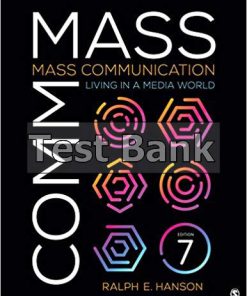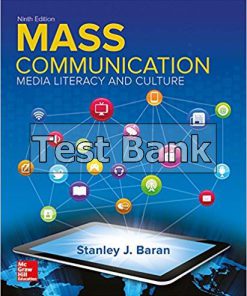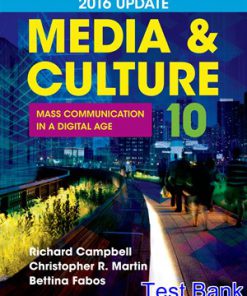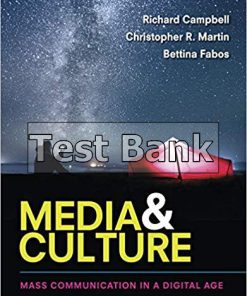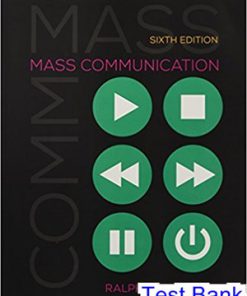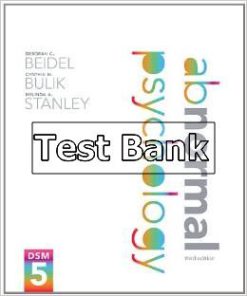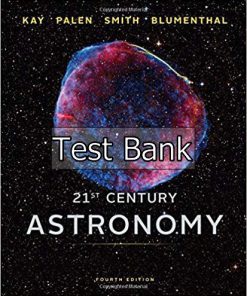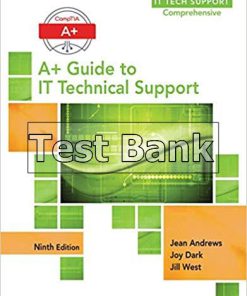Media and Culture Mass Communication in a Digital Age 9th Edition Campbell Test Bank
$26.50$50.00 (-47%)
Media and Culture Mass Communication in a Digital Age 9th Edition Campbell Test Bank.
You may also like
-
$26.50
$50.00
Media and Culture Mass Communication in a Digital Age 9th Edition Campbell Test Bank
 Product details:
Product details:
- ISBN-10 : 1457634597
- ISBN-13 : 978-1457634598
- Author: RICHARD CAMPBELL
Mass media have taken the digital turn: they have made the transition from the analog past into our digital future. Today’s communication students need a book that keeps pace with those changes—and with their own experiences as media consumers. While students may be familiar with the latest technology, Media & Culture can help enhance their understanding of how we arrived at this point, and where we’re headed. The new edition explores the effects of the digital turn with new and informative part openers that dig into our media consumption habits, a brand-new chapter on digital gaming that goes deeper and further than other media books, and an integrated VideoCentral program throughout the book that converges the print text with the Web. Using its signature critical process and cultural perspective, Media & Culture shows how digital media really work—and how students can become informed media consumers and critics.
Table contents:
Chapter 1: Mass Communication: A Critical Approach
Culture and the Evolution of Mass Communication
Oral and Written Eras in Communication
The Print Revolution
The Electronic Era
The Digital Era
The Linear Model of Mass Communication
A Cultural Model for Understanding Mass Communication
The Development of Media and Their Role in Our Society
The Evolution of Media: From Emergence to Convergence
Media Convergence
Stories: The Foundation of Media
The Power of Media Stories in Everyday Life
Surveying the Cultural Landscape
EXAMINING ETHICS Covering War
Culture as a Skyscraper
CASE STUDY The Sleeper Curve
Culture as a Map
Cultural Values of the Modern Period
Shifting Values in Postmodern Culture
Critiquing Media and Culture
Media Literacy and the Critical Process
MEDIA LITERACY AND THE CRITICAL PROCESS
Benefits of a Critical Perspective
GLOBAL VILLAGE Bedouins, Camels, Transistors, and Coke
CHAPTER REVIEW
PART 1: DIGITAL MEDIA AND CONVERGENCE
Chapter 2: The Internet, Digital Media, and Media Convergence
The Development of the Internet and the Web
The Birth of the Internet
The Net Widens
The Commercialization of the Internet
The Web Goes Social
What is Social Media?
Types of Social Media
Social Media and Democracy
EXAMINING ETHICS The “Anonymous” Hackers of the Internet
Convergence and Mobile Media
Media Converges on Our PCs and TVs
Mobile Devices Propel Convergence
The Impact of Media Convergence and Mobile Media
The Next Era: The Semantic Web
The Economics and Issues of the Internet
Ownership: Controlling the Internet
GLOBAL VILLAGE Designed in California, Assembled in China
Targeted Advertising and Data Mining
MEDIA LITERACY AND THE CRITICAL PROCESS Search Engines and the Critical Process
Security: The Challenge to Keep Personal Information Private
Appropriateness: What Should Be Online?
Access: The Fight to Prevent a Digital Divide
Net Neutrality: Maintaining an Open Internet
Alternative Voices
The Internet and Democracy
CHAPTER REVIEW
Chapter 3: Digital Gaming and the Media Playground
The Development of Digital Gaming
Mechanical Gaming
The First Video Games
Arcades and Classic Games
Consoles and Advancing Graphics
Gaming on Home Computers
The Internet Transforms Gaming
MMORPGs, Virtual Worlds, and Social Gaming
Convergence: From Consoles to Mobile Gaming
The Media Playground
CASE STUDY Thoughts of Video Game Narrative
Video Game Genres
Communities of Play: Inside the Game
Communities of Play: Outside the Game
Trends and Issues in Digital Gaming
Electronic Gaming and Media Culture
Benefits of a Critical Perspective
Electronic Gaming and Advertising
Addiction and Other Concerns
GLOBAL VILLAGE BOX South Korea’s Gaming Obsession
MEDIA LITERACY AND THE CRITICAL PROCESS First-Person-Shooter Games
Regulating Gaming
The Future of Gaming and Interactive Environments
The Business of Digital Gaming
The Ownership and Organization of Digital Gaming
The Structure of Digital Game Publishing
Selling Digital Games
Alternative Voices
Digital Gaming, Free Speech, and Democracy
CHAPTER REVIEW
PART 2: SOUNDS AND IMAGES
Chapter 4: Sound Recording and Popular Music
The Development of Sound Recording
From Cylinders to Disks: Sound Recording Becomes a Mass Medium
From Phonographs to CDs: Analog Goes Digital
Convergence: Sound Recording in the Internet Age
The Rocky Relationship between Records and Radio
U.S. Popular Music and the Formation of Rock
The Rise of Pop Music
Rock and Roll Is Here to Stay
Rock Muddies the Waters
Battles in Rock and Roll
A Changing Industry: Reformations in Popular Music
The British Are Coming!
Motor City Music: Detroit Gives America Soul
Folk and Psychedelic Music Reflect the Times
MEDIA LITERACY AND THE CRITICAL PROCESS Music Preferences across Generations
Punk, Grunge, and Alternative Respond to Mainstream Rock
Hip-Hop Redraws Musical Lines
The Reemergence of Pop
The Business of Sound Recording
TRACKING TECHNOLOGY The Song Machine: The Hitmakers behind Rihanna
CASE STUDY In the Jungle, the Unjust Jungle, a Small Victory
Alternative Voices
Sound Recording, Free Expression, and Democracy
CHAPTER REVIEW
Chapter 5: Popular Radio and the Origins of Broadcasting
Early Technology and The Development of Radio
Maxwell and Hertz Discover Radio Waves
Marconi and the Inventors of Wireless Telegraphy
Wireless Telephony: De Forest and Fessenden
Regulating a New Medium
The Evolution of Radio
The RCA Partnership Unravels
Sarnoff and NBC: Building the “Blue” and “Red” Networks
Government Scrutiny Ends RCA-NBC Monopoly
CBS and Paley: Challenging NBC
Bringing Order to Chaos with the Radio Act of 1927
The Golden Age of Radio
Radio Reinvents Itself
Transistors Make Radio Portable
The FM Revolution and Edwin Armstrong
The Rise of Format and Top 40 Radio
CASE STUDY Host: The Origins of Talk Radio
Resisting the Top 40
The Sounds of Commercial Radio
Format Specialization
Nonprofit Radio and NPR
Global Village: Radio Mogadishu
MEDIA LITERACY AND THE CRITICAL PROCESS Comparing Commercial and Noncommercial Radio
New Radio Technologies Offer More Stations
Radio and Convergence
The Economics of Broadcast Radio
Local and National Advertising
Manipulating Playlists with Payola
Radio Ownership: From Diversity to Consolidation
Alternative Voices
Radio and The Democracy of The Airways
CHAPTER REVIEW
Chapter 6: Television & Cable: The Power of Visual Culture
The Origins and Development of Television
Early Innovations in TV Technology
Controlling Content TV—Grows Up
The Development of Cable
CATV—Community Antenna Television
The Wires and Satellites behind Cable Television
Cable Threatens Broadcasting
Cable Services
CASE STUDY ESPN: Sports and Stories
DBS: Cable without Wires
Technology and Third Screens Change Viewing Habits Home Video The Third Screen: TV Converges with the Internet Fourth Screens: Smartphones and Mobile Video Major Programming Trends
TV Entertainment: Our Comic Culture TV Entertainment: Our Dramatic Culture
TV Information: Our Daily News Culture Reality TV and Other Enduring Trends MEDIA LITERACY AND THE CRITICAL PROCESS TV and the State of Storytelling Public Television Struggles to Find its Place Regulatory Challenges to Television and Cable
Government Regulations Temporarily Restrict Network Control Balancing Cable’s Growth against Broadcasters’ Interests
Franchising Frenzy
The Telecommunications Act of 1996
The Economies and Ownership of Television and Cable Production Distribution Syndication Keeps Shows Going and Going . . . Measuring Television Viewing The Major Programming Corporations
TRACKING TECHNOLOGY Streaming Dreams: YouTube Turns Pro
Alternative Voices
Television, Cable, and Democracy
CHAPTER REVIEW
Chapter 7: Movies and the Impact of Images
Early Technology and The Evolution of Movies
The Development of Film
The Introduction of Narrative
The Arrival of Nickelodeons
The Rise of the Hollywood Studio System
Production
Distribution
Exhibition
The Studio System’s Golden Age
Hollywood Narrative and the Silent Era
The Introduction of Sound
The Development of the Hollywood Style
CASE STUDY Breaking through Hollywood’s Race Barrier
Outside the Hollywood System
GLOBAL VILLAGE Beyond Hollywood: Asian Cinema
The Transition of the Studio System
The Hollywood Ten
The Paramount Decision
Moving to the Suburbs
Television Changes Hollywood
Hollywood Adapts to Home Entertainment
The Economics of the Movie Business
Production, Distribution, and Exhibition Today
MEDIA LITERACY AND THE CRITICAL PROCESS Blockbuster Mentality
The Major Studio Players
Convergence: Movies Adjust to the Internet Age
Alternative Voices
Popular Movies and Democracy
CHAPTER REVIEW
PART 3: WORDS AND PICTURES
Chapter 8: Newspapers: The Rise and Decline of Modern Journalism
The Evolution of American Newspapers
Colonial Newspapers and the Partisan Press
The Penny Press Era: Newspapers Become Mass Media
The Age of Yellow Journalism: Sensationalism and Investigation
Competing Models of Modern Print Journalism
“Objectivity” in Modern Journalism
Interpretive Journalism
Literary Forms of Journalism
Contemporary Journalism in the TV and Internet Age
The Business and Ownership of Newspapers
Consensus vs. Conflict: Newspapers Play Different Roles
MEDIA LITERACY AND THE CRITICAL PROCESS Covering Business and Economic News
Newspapers Target Specific Readers
Newspaper Operations
CASE STUDY Alternative Journalism: Dorothy Day and I.F. Stone
Newspaper Ownership: Chains Lose Their Grip
Joint Operating Agreements Combat Declining Competition
Challenges Facing Newspapers Today
Readership Declines in the United States
Going Local: How Small and Campus Papers Retain Readers
Blogs Challenge Newspapers’ Authority Online
GLOBAL VILLAGE For U.S. Newspaper Industry, an Example in Germany?
Convergence: Newspapers Struggle in the Move to Digital
New Models for Journalism
Alternative Voices
Newspaper and Democracy
CHAPTER REVIEW
Chapter 9: Magazines in the Age of Specialization
The Early History of Magazines
The First Magazines
Magazines in Colonial America
U.S. Magazines in the Nineteenth Century
National, Women’s and Illustrated Magazines
The Development of Modern American Magazines
Social Reform and Muckrakers
The Rise of General-Interest Magazines
CASE STUDY The Evolution of Photojournalism
The Fall of General-Interest Magazines
Convergence: Magazines Confront the Digital Age
The Domination of Specialization
TRACKING TECHNOLOGY The New “Touch” of Magazines
Men’s and Women’s Magazines
Sports, Entertainment, and Leisure Magazines
Magazines for the Ages
Elite Magazines
MEDIA LITERACY BOX Uncovering American Beauty
Minority-Targeted Magazines
Supermarket Tabloids
The Organization and Economics of Magazines
Magazine Departments and Duties
Major Magazine Chains
Alternative Voices
Magazines in a Democratic Society
CHAPTER REVIEW
Chapter 10: Books and the Power of Print
The History of Books from Papyrus to Paperbacks
The Development of Manuscript Culture
The Innovations of Block-Printing and Movable Type
The Gutenberg Revolution: The Invention of the Printing Press
The Birth of Publishing in the United States
Modern Publishing and the Book Industry
The Formation of Publishing Houses
Types of Books
CASE STUDY Comic Books: Alternative Themes, but Superheroes Prevail
Trends and Issues in Book Publishing
Influences of Television and Film
Audio Books
Convergence: Books in the Digital Age
Preserving and Digitizing Books
TRACKING TECH Did Publishers and Apple Collude Against Amazon?
Censorship and Banned Books
MEDIA LITERCY AND THE CRITICAL PROCESS Banned Books and “Family Values”
The Organization and Ownership of the Book Industry
Ownership Patterns
The Structure of Book Publishing
Selling Books, Stores, Clubs, and Mail Order
Alternative Voices
Books and the Future of Democracy
CHAPTER REVIEW
PART 4: THE BUSINESS OF MASS MEDIA
Chapter 11: Advertising and Commercial Culture
Early Developments in American Advertising
The First Advertising Agencies
Advertising in the 1800s
Promoting Social Change and Dictating Values
Early Ad Regulation
The Shape of U.S. Advertising Today
The Influence of Visual Design
Types of Advertising Agencies
The Structure of Ad Agencies
Trends in Online Advertising
Persuasive Techniques in Contemporary Advertising
Conventional Persuasive Strategies
The Association Principle
CASE STUDY Idiots and Objects: Stereotyping in Advertising
Advertising as Myth
Product Placement
EXAMINING ETHICS Brand Integration, Everywhere
MEDIA LITERACY AND THE CRITICAL PROCESS The Branded You
Commercial Speech and Regulating Advertising
Critical Issues in Advertising
GLOBAL VILLAGE Smoking Up the Global Market
Watching Over Advertising
Alternative Voices
Advertising, Politics, and Democracy
Advertising’s Role in Politics
The Future of Advertising
CHAPTER REVIEW
Chapter 12: Public Relations and Framing Message
Early Developments in Public Relations
P.T. Barnum and Buffalo Bill
Big Business and Press Agents
The Birth of Modern Public Relations
The Practice of Public Relations
Approaches to Organized Public Relations
Performing Public Relations
CASE STUDY Social Media Transform the Press Release
EXAMINING ETHICS What Does It Mean to be Green?
Public Relations Adapts to the Internet Age
Public Relations during a Crisis
Tensions between Public Relations and the Press
Elements of Professional Friction
Shaping the Image of Public Relations
Alternative Voices
Public Relations and Democracy
MEDIA LITERACY AND THE CRITICAL PROCESS The Invisible Hand of PR
CHAPTER REVIEW
Chapter 13: Media Economics and the Global Marketplace
Analyzing the Media Economy
The Structure of the Media Industry
The Performance of Media Organizations
The Transition to an Information Economy
Deregulation Trumps Regulation
Media Powerhouses: Consolidation, Partnerships, and Mergers
Business Tendencies in Media Industries
Economics, Hegemony, and Storytelling
Specialization and Global Markets
The Rise of Specialization and Synergy
CASE STUDY Minority and Female Media Ownership: Why Does it Matter?
Disney: A Postmodern Media Conglomerate
Global Audiences Expand Media Markets
The Internet and Convergence Change the Game
Social Issues in Media Economics
MEDIA LITERACY AND THE CRITICAL PROCESS Cultural Imperialism and Movies
CASE STUDY From fifty to a Few: The Most Dominant Media Corporations
The Limits of Antitrust Laws
The Fallout from a Free Market
Cultural Imperialism
The Media Marketplace and Democracy
The Effects of Media Consolidation on Democracy
The Media Reform Movement
CHAPTER REVIEW
PART 5: DEMOCRATIC EXPRESSION AND THE MASS MEDIA
Chapter 14: The Culture of Journalism: Values, Ethics, and Democracy
Modern Journalism in the Information Age
What Is News?
Values in American Journalism
Ethics and the News Media
CASE STUDY Bias in the News
Ethical Predicaments
Resolving Ethical Problems
Reporting Rituals and the Legacy of Print Journalism
Focusing on the Present
MEDIA LITERACY AND THE CRITICAL PROCESS Telling Stories and Covering Disaster
Relying on Experts
Balancing Story Conflict
Acting as Adversaries xx
Journalism in the Age of TV and the Internet
Differences between Print and TV News
Pundits, “Talking Heads,” and Politics
Convergence Enhances and Changes Journalism
The Power of Visual Language
Alternative Models: Public Journalism and “Fake” News
The Public Journalism Movement
GLOBAL VILLAGE Why Isn’t Al Jazeera English on More U.S. TV Systems?
“Fake” News and Satiric Journalism
Democracy and Reimagining Journalism’s Role
Social Responsibility
Deliberative Democracy
EXAMINING ETHICS Wikileaks, Secret Documents, and Good Journalism?
CHAPTER REVIEW
Chapter 15: Media Effects and Cultural Approaches to Research
Early Media Research Methods
Propaganda Analysis
Public Opinion Research
Social Psychology Studies
Marketing Research
CASE STUDY The Effects of TV in a Post-TV World
Research on Media Effects
Early Theories of Media Effects
Conducting Media Effects Research
MEDIA LITERACY AND THE CRITICAL PROCESS First-Person Shooter Games: Misogyny as Entertainment?
Contemporary Media Effects Theories
Evaluating Research on Media Effects
Cultural Approaches to Media Research
Early Developments in Cultural Studies Research
Conducting Cultural Studies Research
CASE STUDY Labor Gets Framed
Cultural Studies’ Theoretical Perspectives
Evaluating Cultural Studies Research
Media Research and Democracy
CHAPTER REVIEW
Chapter 16: Legal Controls and Freedom of Expression
The Origins of Free Expression and a Free Press
Models of Expression
The First Amendment of the U.S. Constitution
Censorship as Prior Restraint
Unprotected Forms of Expression
MEDIA LITERACY AND THE CRITICAL PROCESS Who Knows the First Amendment?
CASE STUDY Is “Sexting” Pornography?
The First Amendment versus Sixth Amendment
Film and the First Amendment
Social and Political Pressures on the Movies
Self-Regulation in the Movie Industry
The MPAA Ratings System
Expression in the Media: Print, Broadcast, and Online
The FCC Regulates Broadcasting
Dirty Words, Indecent Speech, and Hefty Fines
Political Broadcasts and Equal Opportunity
The Demise of the Fairness Doctrine
Communication Policy and the Internet
EXAMINING ETHICS A Generation of Copyright Criminals?
The First Amendment and Democracy
CHAPTER REVIEW
Extended Case Study: Our Digital World and The Self-Invasion of Privacy
Step 1: Description
Step 2: Analysis
Step 3: Interpretation
Step 4: Evaluation
Step 5: Engagement
Notes
Glossary
Index
People also search:
what is mass media and society
what is mass media and communication course
what is mass media and communication
how do mass media and social media differ
media and culture mass communication in a digital age pdf

